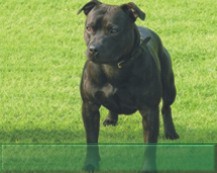 |
Early Training for Good Behaviour
Dr
Quixi Sonntag (BVSc) (Hons)
The experiences of a young
child heavily influence what the child will become as an adult. The
same is true of dogs and cats. While genetics provide the foundation
of behavioural and physical characteristics, the environmental
influences that puppies are exposed to ultimately shape their adult
temperament and behaviour.
These influences have and
effect from as early as the first week of their lives. Research
shows that puppies that are gently handled from the first week,
develop better adaptive skills and are more sociable when they are
older, than those that are not handled.
Although
traditionally the so-called “socialisation period” (the most
sensitive time of environmental influences) for puppies has been
said to be from 3 to 16 weeks of age, it is now thought that the
most significant period is from 3 to 5 weeks.
What are the practical
implications? Breeders, who are responsible for puppies until at
least 7 weeks of age, have an important responsibility in terms of
ensuring that the early environmental influences of puppies are
favourable for their good behavioural and physical development.
Puppies need to be exposed
in a controlled and pleasant manner to those stimuli that will form
part of their adult environment. These stimuli include interaction
with people, introducing to new sounds, sights and location. If
young animals, in their sensitive developmental period, are
pleasantly exposed to all the stimuli they may come across in the
outside world, they will be likely to view new things with interest
and positive anticipation, rather than with fear an apprehension.
Breeders can play an
active role in ensuring the mental well being of “their” offspring
by paying special attention to the following:
- Gentle handling of
puppies from the first week improves their adaptive
capabilities.
- From the second week
onwards, puppies need to be exposed to visual stimuli. As their
eyes open at around two weeks of age, it is essential that
puppies be exposed to light and other visual stimuli to ensure
that the structures of the eye develop normally. Lack of visual
stimulation e.g. being reared in a dark environment such as a
garage, will hamper normal visual development of the young dog.
- The ear canals open at
more or less the same time as the eyes, and so puppies should be
exposed to household sounds at a normal intensity (not so loud
that is causes fear) from early on. Vacuum cleaners,
lawnmowers, children laughing and alarms are examples of the
types of sounds that pets would be exposed to in the course of
their lives. Breeders could use cassettes of
CDs of normal daily sounds to play to their litters
during feeding or playtime to ensure positive associations with
these sounds.
- Social relationships
begin to form when puppies can see and hear each other and are
no longer solely dependent on their mothers for physical
comfort. Single puppies should ideally be exposed to other
puppies of more or less the same age to ensure that they learn
proper interspecies social skills
- Not only the
relationships between littermates, but also the relationship
with people are important. Puppies need a lot of social
interaction with people of different appearances and
dispositions. Puppies that grow up in a kennel environment must
have regular, controlled interaction with different people (of
different size, gender, race and general appearance) so that
they develop appropriate hog-human social skills.
- Puppies must be exposed
to different location and a variety of surfaces such as grass,
soil, tiles and carpet. They also need to be accustomed to
crates or cages in a positive manner so that temporary
confinement later on (e.g. for travelling purposes) will not be
a traumatic experience for them.
- Exposure to inanimate
objects is as important as exposure to living creatures. Get
them used to food bowls, collars (particularly puppies), toys,
umbrellas, thing with wheels, black plastic bags, brooms and
other common household implements. Equipment such as small
ramps and obstacles in the puppy pen helps them develop their
movement skills and develop body awareness. The more pleasant
exposure the young puppy gets, the more self-confident they will
be as older pets.
- Toilet training is an
important responsibility of the breeder. Puppies must be taken
out regularly onto acceptable elimination surfaces. Puppies
tend to eliminate after having slept, eaten or played. If a
breeder is able to devote the necessary time, puppies can be
almost fully housetrained by the time they go to their new
homes.
- Teaching good manners
should already start from around 5 weeks! A litter of puppies
can easily be taught not to jump up against people and to sit
before the eat.
The best age to remove
puppies to their new homes is at 7 to 9 weeks. Puppies undergo a
huge amount of development during the sixth week of age. This, the
age at which puppies are traditionally homed, is in fact not a good
age to place them in a new environment. Puppies develop a very
strong “site” (nesting area) attachment at this age, and being moved
to a permanent new location at this age cause a great deal of
stress.
Generally, 8 weeks is a good
age to wean puppies, provided they have had their first vaccination,
at least one de-worming and have been eating a veterinarian
recommended pet food appropriate for their age and size (in the case
of puppies) for 4 weeks or more. Human baby formula, porridge and
pap are not appropriate foods for puppies.
If as a breeder you are able to devote more time
to instilling good behaviour in your puppies, you will better equip
them to cope with what life has in store for them. This will result
in improved quality of life for both pets.. and owners too!
|
 |


